Moharram, a festival of mourning is largely associated with Shia, a Muslim sect in India where large processions are carried out every year to commemorate the death of the grandson of the founder of Islam. The centre of attraction to such processions remains the Taziya, a visual representation of Hussain’s tomb. The other sect of Islam Sunnis also celebrates this festival in ways different from the traditional Shia. In the recent past, these processions have peddled various controversies from having DJs to stone peltings to weaving swords to ‘Sar tan se Juda’ slogans and whatnot. Was it the same in the past as well?
Well, this piece will take you through the historical background and the recent advancements to the culture and traditions added or removed with the Moharram processions by different sects of Islam.
Last year there were processions with loud music playing by DJs. It is a known fact that Islamists and Mosques always had a problem with loudspeakers and music. We even had a number of instances where people are even murdered over our Music. But there is surely some change in the Islamic beliefs as now we see DJs being played, bands being called and all of this in a ‘mourning festival’.
Readers can go through this report by Organiser where we compiled a list of threatening songs played in such processions over the years.
It is pertinent to mention here that Muharram has been observed as a festival of mourning ever since the grandson of the Prophet, Hussain died in the ‘Battle of Karbala’ we will discuss the battle ahead in this research.
This article comprises details from the past and the advancements which the festival of Muharram made over the years. From the battle of Karbala to the Auragzeb’s invasion to India, the festival had adopted a lot. Later the article discusses how carrying Taziya popularised in India, with Shia, Sunni and even Hindu Taziya. How people started immersing the structure in water and much more.
A brief chronological history of the Islamic empire before the ‘Battle of Karbala’
It is helpful to keep in mind the basic political chronology of the Muslim Empire during the period from 632 to 1258, as it led to major changes and challenges to get a proper context of the Muharram.
Following the death of the Founder of Islam in 632 there were three successive caliphates, the Rashedins (632-61), the Umayyads (661-750) and the Abbasids (750-1258). All three ruled in succession over nearly the entire Muslim empire.
The Sunni sect of Islam refers to the immediate successors of the founder of Islam as the Rashedin caliphs, who include Abu Bakar (632-34), Omar Ebn-e Abi Taleb (634-644), Othman Ebn-e Affan (644-656) and Ali Ebn-e Abi Taleb (556-661). These four caliphs were close associates or relatives of the Prophet, unlike their later representatives. These caliphs were considered highly pious by the Sunnis.
These were followed by the Umayyads from 661 to 750 who were considered highly corrupt by the Shias. Shias are the ones who follow the Prophet but do not belong to the family, they do not believe in the caliphs but in the ones appointed by the prophet himself. They consider the caliphs does not belong to the prophet’s family. It was in this period that the battle of Karbala was fought.
In 749-50, the Umayyads were overthrown by the Abbasids who assumed the caliphate and ruled Iraq until 1258. Significantly Abbasids made fairly extensive use of popular Shia sentiments in mobilizing opposition from the Umayyads. However, they assumed Shias as a threat to their legitimacy.
This was a period of political and religious divisions in Islam. Beginning with the death of the Prophet, there began attempts of succession. The first was the war of Ridda in 632, where Abu Bakar, the first caliph, prevented an Arab invasion. Then Othman, the Caliph during the Rashedin period in 656 was killed by an angry mob, then came Ali who fought the battle of Camel in 656 and the battle of Siffin in 657 during which he was forced to agree to arbitration with the powerful general Moawia, who later established the Umayyad caliphate in 661, after which Ali was assassinated by a group of miscreants.
These conflicts intensified in the Umayyad period and in 680 when the battle of Karbala was fought in which the grandson of the prophet, Hossain (today called Hussain) was massacred with seventy of his relatives by the troops of the second Umayyad Caliph, Yazid.
During the Umayyad and the early Abbasid period, Shi’ism was in its formative stage, which means it was highly diverse. Many branches of Shi’ism came and went extinct.
The ‘Battle of Karbala’
There are various versions of this battle story available in the common discourse. The battle occurred in 680 in a deserted region of Iraq called Karbala. The most famous of all the accounts is of an Arab scholar, al-Tabari given in the year 923. Rather than its historical accuracy, it largely depends on the fact that how much Shias have considered and followed their versions.
The most common narrative begins with the discontent of Muslims with the rule of the second Umayyad Caliph, Yazid. He has been portrayed as politically corrupt and an oppressive ruler. After the death of Ali, the Prophet’s grandson Hussain received various letters from his subjects in Iraq asking him to travel to them to fight against the mistreatment of Yazid from the medina. When his force failed to stop Yazid, Hussain and his close relatives left for southern Iraq from western Arabia.
They reached a desert named Karbala in southern Iraq beside the Euphrates River, where they were surrounded by a superiorly powerful army sent by Yazid. Hussain refused to have a standoff with Yazid by signing an oath of allegiance. After ten days of waiting, talking and fighting Hussain and his male supporters were killed brutally by Yazid’s army. While women and Hussain’s child, Ali Zeyn were transported along with the heads of the martyrs to Damascus at the Yazid’s court. Along the way, they were exhibited at every market and square. The heads of the dead were later placed over spears at Yazid’s court.
The people following the Shia sect draw many of their religious beliefs and practices from this incident and its struggle. They call the supporters of Hussain the ultimate servant of god and consider the women with him as the ideal woman who can support their male counterparts in suffering. They believe by mourning the fate of the family of Mohammad, Hussain and his relatives they can attain salvation.
Mourning for Hussain and his supporters can be traced back to the period of the battle of Karbala itself. But the holding of processions to Karbala with symbols and replicas of Hussain’s tomb, calling it Muharram, has no record until the tenth century in Arabic literature.
The first such mourning procession was held in 963 in the region of Mo’ezz al-Dowleh, the Buyid ruler of southern Iran and Iraq. The Buyid rulers who were Shia themselves promoted the practice of a mourning procession.
From time to time several historians have documented the history of the Battle of Karbala after this and those documents have mentioned Muharram processions every time.
The major developments of the Shia rituals came with the region of Safavid rulers in 1501.
Ever since the Safavid era came into being the Shia rituals took on new meanings. The rulers themselves were Shia so there were no such restrictions, they could publicly express their sense of community and their sentiments towards the Sunnis. For example, they could openly condemn the first three caliphs Abu Bakar, Omar and Othman who have been considered righteous by the Sunnis. Earlier rituals were followed in which Sunnis have a major share but ever since Safavids came into being they created a safe environment for the Shias.
Where did the Taziya come from?
The most significant development of the sixteenth century was the emergence of a new practice called ‘rowzeh khani’ a ritual sermon of recounting and mourning the incident of Karbala. This ritual came into existence after a text compilation Rowzat al-shohada (the garden of Martyrs) by Hoseyn Baez Kashefi in 1502. He drew narratives from various Arab historians to compile this text. In rowzeh khani sermons are taken from the text by Kashefi and are improvised by a trained speaker so as to move the audience into tears through its recitation of the tragic incident of Karbala. This type of ritual is linked with Shias who believe ‘one who mourns for Hussain will attain salvation’.
By 1796 the ritual of rowzeh khani evolved into much more so-called as shabih khani or Taziyeh Khani. The Taziyeh was an elaborate ritual, or say drama of the story of Karbala based on the narrative of rowzeh khani.
The Taziyeh involved a large cast of professional and amateur actors, a director, a staging area, elaborate costumes and props. Taziyeh attained the greatest popularity until 1925 by the end of the Qajar period. After which it began slowing down and started declining.
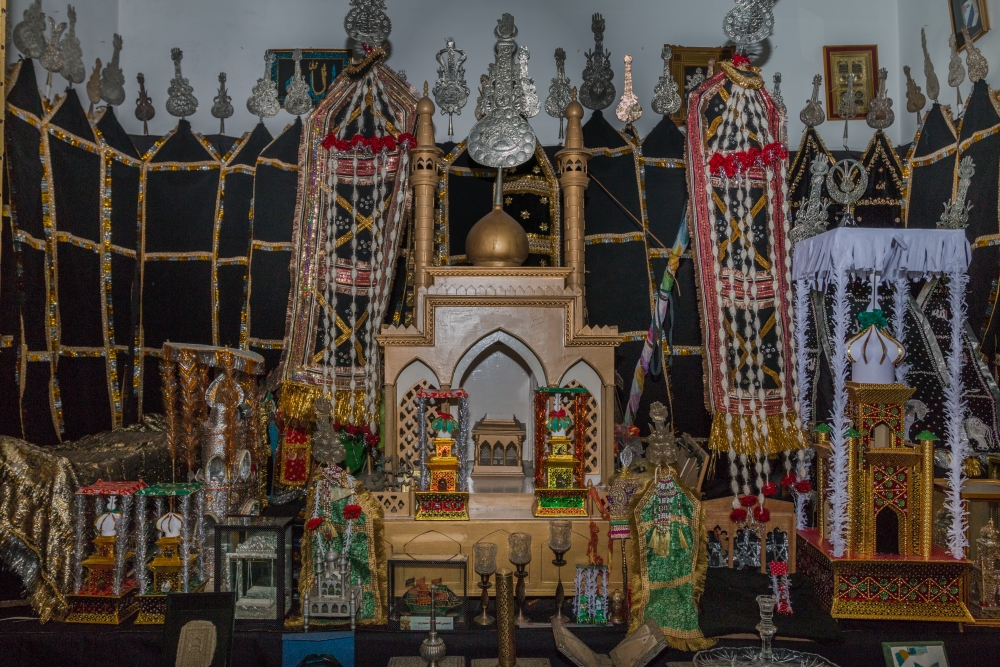
However, Taziyeh continued to exist in Iran and other Islamic follower countries, especially in the cities and rural areas. Because of the grand scale of the urban Taziyeh, it served as one of the best examples showing the wealthy and elite following the Shia rituals.
By the twentieth century, Taziyeh was banned in Iran as Iranian elites became less interested in investing in such rituals and events. Scholars, historians and governments have tried to revive the culture of Taziyeh again in Iran but they have failed miserably by just being able to hold it as an artefact rather than a living tradition.
The above-mentioned facts are taken from the book “The Martyrs of Karbala: Shi’i Symbols and rituals in Modern Iran” by Aghaie and Kamran Scot. The copy was published by the University of Washington Press in Seattle.
How did the tradition of Taziyeh come to India?
The tomb of Hussain was at Karbala and there was no reason why it should not be allowed to become a pilgrimage centre with rising Shia control politically. Soon Karbala became a scene of passionate play celebrated each year in the month of Muharram in which coffins of Martyrs were carried in the procession to bury them at the most pious place to attain salvation. The great mass Muslim population ignorant of the history and feelings accepted the festival as a solemn commemoration of the grandson of the Prophet.
In countries far from Iraq and especially in India, the celebration was limited except amongst the extremists who organise great processions on the tenth day of Muharram. The main centre of attraction in such a procession remained the Tazias, a construction of paper and tinsel over bamboo, representing the tomb of Hussain at Karbala. The procession displayed acrobatic swordplay, while its funeral character was preserved by a custom of burying Tazias in suitable plots.
Taziya, the word came from the Arabic word ‘aza’ which means commemorating the dead. Taziya is a symbol around which the practice of Azadari (mourning ritual at Karbala) revolves. Azadari symbolizes respect for the martyrs of Karbala who were not buried after dying on the battlefields.
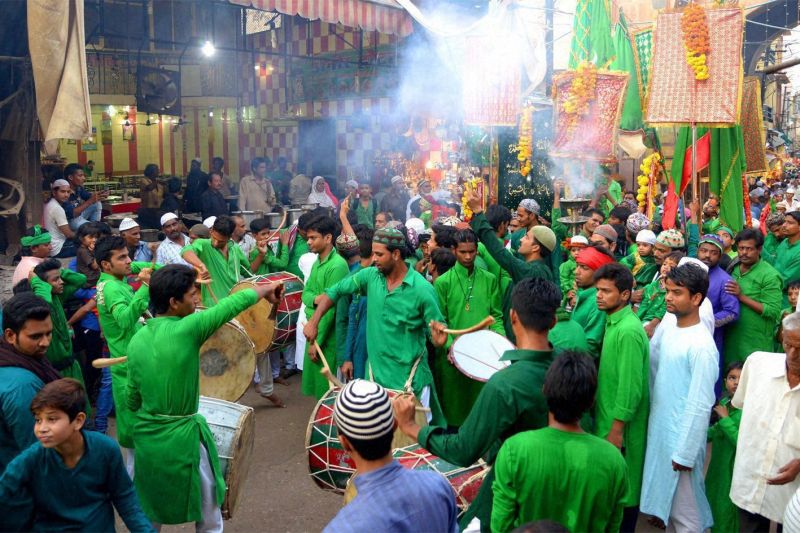
The journey of Tazia in India is linked with Taimur, the Mongol ruler who started this trend in the fourteenth century.
It has been mentioned in history that when Taimur was in conquest in India, he used a replica of Hussain and asked his people to mourn Hussain’s martyrdom.
He kept the replica on an elevated platform and paraded it across the whole camp. Soon this practice was acquired by many followers of Islam in India, people started making replicas of the Mausoleum with different crafts on the occasion of Moharram.
Taziya and Taimur are associated largely by the researchers of Islam in India and across the world but there is no authentic source of origin of this practice in history. There are various stories around this idea but no such fact covers it, wrote Islamic scholar Qibla Ali Naqi Naqvi.
Many historians believe that the Taimur parade with Tazia happened at a camp in Delhi, while others believe it happened somewhere else in South Asia. The believers of the second idea say that the tradition of holding a procession with Tazia started in Humayun’s region.
Various Western writers including a Dutch traveler Francisco Palsaert in the seventeenth century mentioned Taboot (a coffin) alongside the Muharram processions. These writers have mentioned words like tomb, taziya, and cenotaph while elaborating on the Muharram festival from their period.
Taimur is considered to be a Shia Muslim since he gave rise to the Taziya practice and he was a great admirer of Hussain. But there is no evidence to justify this thought.
Another story that links Taziya with Taimur is from an imambada next to Nizamuddin Dargah in Delhi, which claims to have had Taziya from the time of Taimur. Every year the same Taziya is carried on the day of Ashura and taken to the burial ground from where it is again taken back to the dargah to use in Muharram next year.
Whatsoever be the beginning of taziya journey in India be it Taimur or the Mughals, Awadh rulers were the ones who popularised it. At the time of nawab Asif-Ud-Daula, it is said that the nawab and his people used to visit the houses of the people having taziya to offer prayers and would even offer a large sum of money. Various Imams and Maulana used to pay homage to taziya and offer huge sums of money. During the whole nawabi period large imambadas were constructed. The tazia processions were held which showcase the Taziya made by different artists. Then began the practice of military bands joining in the procession. More replicas of different shrines joined in the Tazia procession along with Hussain’s.
Taziya came into existence by the nineteenth century and was mostly concentrated around Lucknow.
The most ideal justification for holding a mourning procession with Taziya depicting the battle of Karbala is the distance, it is not always possible to visit the actual Karbala for people living in Asia or especially India.
Maulana Ali Naqi Naqvi writes, ‘nature and rituals of India were both favourable for taziya/azadari to be adopted so well’. The rituals followed in taziya are easily comparable to the Hindu religious followers, taziya could have easily been compared to idol-making in Durga Puja and Ganesh Chaturthi. Many believe that the ritual ceremony of taziya owes its beginning to Hindu festivals of carrying shrines and idols.
The details on taziya too are more Indianised, for them carrying Indian artwork. There is barely any resemblance between that replica with the real tomb of Hussain.
The writer in his book The Shia of India, John Norman Hollister wrote that Taziya many places do not even look like a replica. The working replica is not ok for the construction of taziya.
Notably, at places the Taziya or the replica of Hussain’s tomb are even immersed in water rather than buried.
Muharram, Tazia and the riots
In his book, Outlaws I have known, a British civil servant in India, posted about the 1900s writes about the Muharram processions in Lucknow and the riots. He says Lucknow was the capital of the old kingdom of Oudh hence it mostly adhered to the Shia sect of Muslims. The dependents still adhere to the customs followed by the Shias. By 1930 Sunnis outnumbered Shias in Lucknow, but the ones with high social status were all Shias. Nowhere in India was the Muharram procession carried out in such a manner as in Lucknow. Taziya remained the centre of attraction to such processions.
Well by the thirties inhabitants of Lucknow generally including people from lower orders like the butchers, weavers and artisans constituting less rank than the Sunnis carried a small and more of isolated procession. They have the same respect and traditions in their mind for Hussain but it is not human nature to arrive at a passion of grief because a man who died over twelve hundred years ago is not still alive. So they tend to dwell on the circumstances of his death as being in themselves tragic. For this some majlises recite the Fatiha aloud, dealing with the story of the descendants of the Prophet and the Hussain. This morning culture is largely followed by Shias but not Sunnis.
The writer described a pamphleteer on the Shia side declaring that, while the two sects were commemorating Muharram on the tenth day, the Shias lamented the fate of Hussain, but Sunnis exulted in the triumph of the army of Yazid (the one whose army killed Hussain). This remark was deeply offensive at that time.
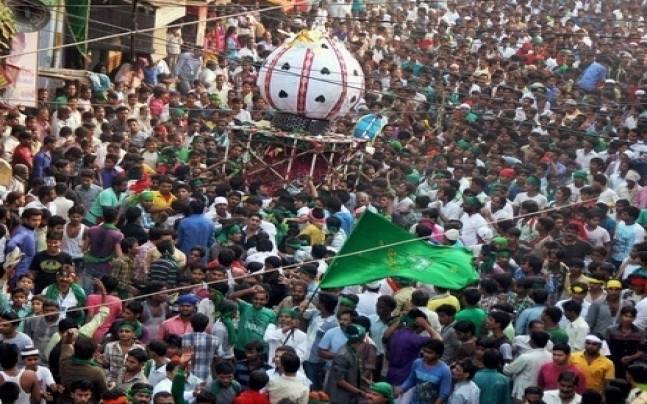
Mohammedans of Lucknow were anyway the minority themselves and the Hindus can readily understand a demonstration in which some object having religious significance is carried out. Thousands of Hindus started joining in the Tazia processions first as spectators. Presumably, some Hindu officials at the service of the king of Oudh must in the first instance have petitioned for permission to carry their tazia. It has become an established tradition in Lucknow that there are Shia Tazia, Sunni Tazia and Hindu Tazia, following one another indiscriminately along the traditional routes ending up at the Shia Karbala. The concluding custom made sure the rituals were followed as per the Shia customs ignoring the other festivities associated with the procession. It is then the tradition of fair and stores around the procession began.
Back then the customs were strict, for example, the ones who have not followed their taziyas with a bare head and feet will not be allowed to enter Karbala. As these restrictions intensified Sunnis started having their own Karbala. So the different taziyas like the Sunni one and the Hindu one were directed to reach the new Karbala sanctioned for the Sunnis. Within years the Shias and Sunnis agreed upon having a traditional Karbala for themselves and hence the new one was abolished.
Before merging again with the Shias, the Sunnis developed a way of carrying processions to their Karbala. They had started singing a song called the ‘Charyari’ songs. The resentment of the Sunni population against Sunnis led to the creation of these songs in honour of Char Yar by which they mean- four caliphs, Abu Bakar, Omar, Usman and Ali. Most of them are sung in honor of Ali the beloved son-in-law of the Prophet.
The author also recalls his days in Amroha where he was appointed, around Muharram. It was a murder incident of a Hindu.
At the district magistrate, a petition came in for having a separate passage for a Hindu wedding procession which was clashing with the tenth day of the Muharram month. The Mohammedans were angry over the fact that a procession carrying music and other stuff will pass by them, during their morning and tazia procession. The government could do nothing then just provide security. Angry with the decision, the mob started accumulating on the streets, they were not dispersing towards home. They gathered in a menacing group in the open, the Hindus were closing down their shutters and started barricading their shops. As soon as the officials started moving towards them there started a shower of brickbats and an ugly rush. This scuffle led to the death of a Hindu man, his skull was beaten in by blows, by quarterstaff of bamboo. There erupted the charge of murder in the course of the riot and 29 Mohamadeans appeared before the court.
While with the trials the murder charge broke down; with no evidence, not a single accused was held accountable for the death of a Hindu. He was unconnected with the petitioner’s family who wanted a passage for his wedding procession side by side with a Moharram procession.
There have been various instances in history and the recent past where the Muslims or Mohamadeans as called at that time, have protested or rioted against loud music clashing their processions or even passing by the mosque.
No record except for the charyari song and use of military bands mention DJs and loud music to be permissible in such processions. Unlike in the past, now Muslims only protest against DJs in Hindu processions and gatherings, they allow the same lour music in the Moharram procession, which is nothing but a festival of mourning.
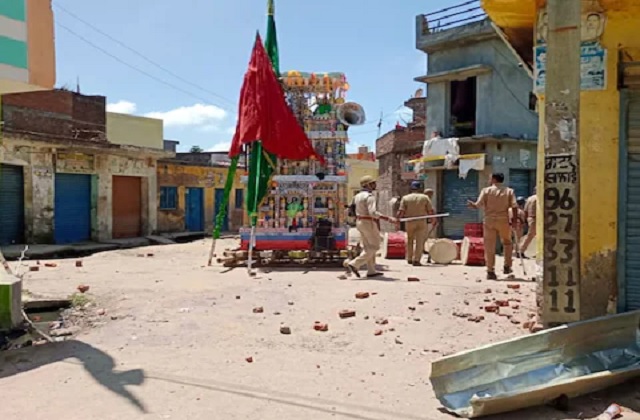
Nowadays there are songs like, ‘topi ko jo lalkarega, use kaat ke rakh denge’, Fek denge kaat ke, aadha idhar aadha udhar’ and more with waving swords in hand.
Last year violent clashes broke out in Bareilly and Varanasi where Islamists carried out Moharram processions and Taziya with DJs on. This year different state governments have restricted the use of DJs or loud music in the processions.


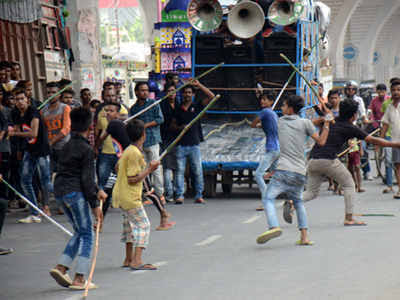
















Comments